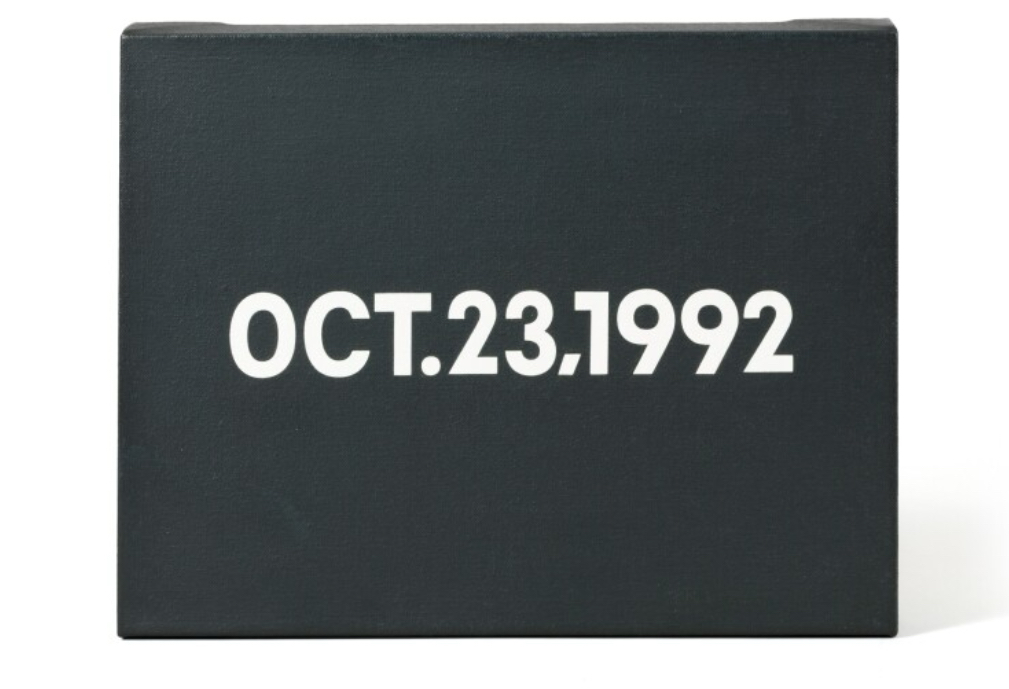On Kawara’s “Date Paintings” are deceptively simple but endlessly profound. His piece from October 23, 1992, one among thousands, is a minimalist expression that invites viewers to reflect on the fleeting nature of time, the convergence of personal and collective histories, and the role of art in engaging with both. This essay will critically analyze Kawara’s work, examining the artistic and philosophical underpinnings of his “Date Paintings”, the context of the October 23, 1992, piece, and its significance in the broader scope of contemporary conceptual art.
The Significance of Time in Kawara’s Art
Kawara’s Date Paintings, formally known as the Today series, began in 1966 and continued until the artist’s death in 2014. The process was simple: each day that Kawara chose to create a new piece, he would paint the date in the language and format of the country he was in at the time. The exacting nature of this practice underscores a key theme in his work: time. But time in Kawara’s art is more than just a chronological marker. It reflects the inevitable passage of days, the human experience of temporality, and the arbitrary ways in which we impose structure on our lives through calendars, clocks, and systems of organization.
In “Oct. 23, 1992”, Kawara’s decision to record the date without further commentary might seem unremarkable at first glance. However, its stark presentation—white text on a monochromatic background—invites viewers to contemplate the date as a stand-alone entity, devoid of context. What was significant about October 23, 1992? Was it a day of personal importance to the artist, or was it simply one of many in the endless stream of dates that make up human existence? By leaving out specifics, Kawara forces viewers to grapple with the ways in which we assign meaning to time, whether personal, historical, or arbitrary.
Kawara is often associated with conceptual art, a movement that emerged in the 1960s and emphasized the idea behind the work over its formal or aesthetic qualities. In many ways, Kawara’s “Date Paintings” embody this ethos. Stripped of any ornamentation, the works seem to reject traditional notions of art as a medium for beauty or expression. Instead, they become conceptual objects—records of time itself, made material through the act of painting.
In reducing the content of his paintings to a date, Kawara is performing a radical act of minimalism. The viewer’s attention is drawn not to the brushstrokes, color palette, or compositional elements that define traditional paintings, but to the concept behind the work: the recognition of a specific day in time. This reduction of meaning aligns with the central concerns of conceptual artists like Sol LeWitt and Lawrence Weiner, who sought to foreground the ideas driving their art rather than the physical objects themselves.
Kawara’s “Oct. 23, 1992” stands as a prime example of conceptual minimalism. The date on the canvas is both everything and nothing; it offers no clues about the artist’s mood, location, or intentions. The viewer is left to reflect on their own relationship with the date, to consider its personal or historical significance. Was it an ordinary day for most people, or did it carry special meaning for some? In presenting the date without context, Kawara invites viewers to project their own experiences and associations onto the work, making the piece as much about the audience as it is about the artist.
Personal and Collective Histories
One of the most compelling aspects of Kawara’s “Date Paintings” is their ability to straddle the line between the personal and the collective. Each painting is an intimate record of a single day in the artist’s life, yet it is also a reflection of the broader world in which that day took place. The inclusion of a box containing a newspaper clipping from the date in question—a component of many, but not all, of the “Date Paintings”—serves as a reminder of the larger historical and political contexts that shape individual lives.
In the case of “Oct. 23, 1992”, the events of the day could range from the mundane to the monumental, depending on one’s perspective. For instance, 1992 was a significant year globally, marked by events like the Maastricht Treaty in Europe, which laid the foundation for the European Union, and the U.S. presidential election, where Bill Clinton would soon be elected. On a more personal level, this date might hold no significance for most people, but for others, it could be the anniversary of a birth, death, or other life-altering event. Kawara’s work thus becomes a meditation on the ways in which personal and collective histories intersect, overlap, and diverge.
The Artistic Process and Ritual
Kawara’s artistic process was one of repetition, discipline, and ritual. He adhered to a strict set of rules in creating his Date Paintings: if a painting was not completed by the end of the day, it would be destroyed. This rule underscores the fleeting nature of time and the impossibility of capturing it fully. The fact that each painting had to be completed within the confines of a single day adds a sense of urgency to the work, even if that urgency is not immediately apparent in the calm, unadorned final product.
The ritualistic nature of Kawara’s practice is also significant. In a way, his daily act of painting a date becomes a form of meditation, a way of marking time that is both deeply personal and universally recognizable. The repetitive nature of the task recalls the work of other minimalist and conceptual artists, such as Agnes Martin or Tehching Hsieh, whose practices similarly involved the disciplined repetition of a specific action over time.
Yet, where Martin’s grids and Hsieh’s year-long performance pieces foreground the physical toll of their respective processes, Kawara’s work remains resolutely detached. There is no evidence of the artist’s hand in the painting, no visible struggle or strain. The date is presented cleanly, without flourish, as though to suggest that the act of recording time is itself neutral, even as the passage of time is anything but.
On Kawara’s “Oct. 23, 1992”, like all of his Date Paintings, is a deceptively simple work that engages deeply with complex ideas about time, history, and the nature of art. By presenting a single date without context, Kawara invites viewers to reflect on the ways in which we assign meaning to time, both personally and collectively. His work challenges traditional notions of art as a medium for aesthetic pleasure or self-expression, instead foregrounding the concept behind the work. In doing so, Kawara transforms the act of painting into a meditation on the passage of time, the intersection of individual and collective histories, and the role of ritual in the artistic process.
The absence of specific meaning in “Oct. 23, 1992” is precisely what makes the work so powerful. It is both a blank slate and a profound statement, asking viewers to confront their own relationship with time and to consider the ways in which art can engage with something as elusive and intangible as a single day in history. In Kawara’s hands, the date becomes more than just a marker of time—it becomes a space for reflection, meditation, and connection.
No comments yet.








